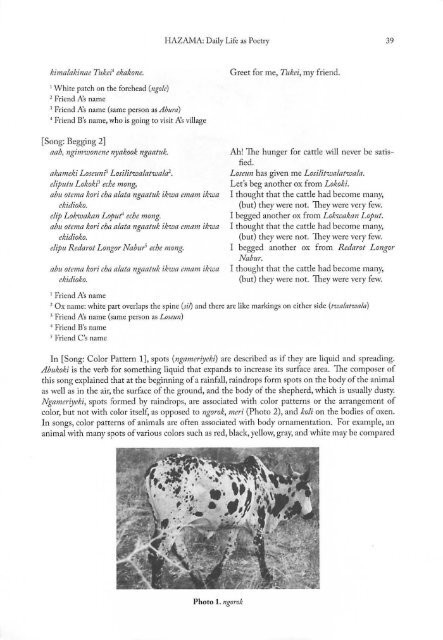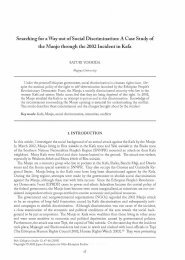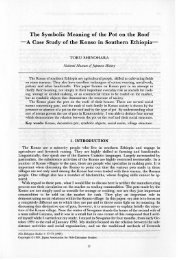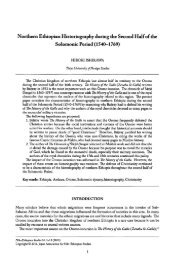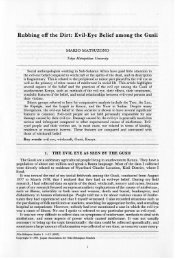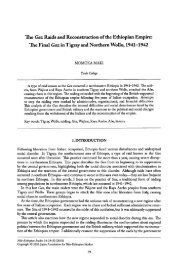Daily Life as Poetry: The Meaning of the Pastoral Songs of the ...
Daily Life as Poetry: The Meaning of the Pastoral Songs of the ...
Daily Life as Poetry: The Meaning of the Pastoral Songs of the ...
Create successful ePaper yourself
Turn your PDF publications into a flip-book with our unique Google optimized e-Paper software.
I-IAZAMA: <strong>Daily</strong> <strong>Life</strong> <strong>as</strong> <strong>Poetry</strong><br />
39<br />
kimalakinae Tukei 4 ekakone.<br />
Greet for me, Tukei, my friend.<br />
1<br />
White patch on <strong>the</strong> forehead (ngole)<br />
2<br />
Friend Ns name<br />
3<br />
Friend fils name (same person <strong>as</strong> Abura)<br />
4<br />
Friend B's name, who is going to visit Ns village<br />
[Song: Begging 2]<br />
aah, ngimwonene nyakook ngaatuk.<br />
Ah! <strong>The</strong> hunger for cattle will never be satis-<br />
fied.<br />
L oseun h<strong>as</strong> given me Losilitwalatwala.<br />
Let's beg ano<strong>the</strong>r ox from Lokoki.<br />
I thought that <strong>the</strong> cattle had become many,<br />
(but) <strong>the</strong>y were not. <strong>The</strong>y were very few.<br />
I begged ano<strong>the</strong>r ox from L okwakan Loput.<br />
I thought that <strong>the</strong> cattle had become many,<br />
(but) <strong>the</strong>y were not. <strong>The</strong>y were very few.<br />
I begged ano<strong>the</strong>r ox from R edarot L ongor<br />
Nabur.<br />
I thought that <strong>the</strong> cattle had become many,<br />
(but) <strong>the</strong>y were not. <strong>The</strong>y were very few.<br />
akameki Loseuni 1 Losilit walatwala'l.<br />
eliputu Lokokt-J eche mong,<br />
abu otema kori cha a lata ngaatuk ikwa emam ikwa<br />
ekidioko.<br />
elip Lokwakan Lopur eche mong.<br />
abu otema kori cha a lata ngaatuk ikwa emam ikwa<br />
ekidioko.<br />
elipu Redarot Longor Nabw 5 eche mong.<br />
abu otema kori cha a lata ngaatuk ikwa emam ikwa<br />
ekidioko.<br />
1<br />
Friend Ns name<br />
2 Ox name: white part overlaps <strong>the</strong> spine (sil) and <strong>the</strong>re are like markings on ei<strong>the</strong>r side (twa/a twa/a)<br />
3 Friend Ns name (same person <strong>as</strong> Loseun)<br />
4<br />
Friend B's name<br />
5<br />
F riend C's name<br />
In [Song: Color Pattern 1], spots (ngameriyeki) are described <strong>as</strong> if <strong>the</strong>y are liquid and spreading.<br />
Abukoki is <strong>the</strong> verb for something liquid that expands to incre<strong>as</strong>e its surface area. 1he composer <strong>of</strong><br />
this song explained that at <strong>the</strong> beginning <strong>of</strong> a rainfall, raindrops form spots on <strong>the</strong> body <strong>of</strong> <strong>the</strong> animal<br />
<strong>as</strong> well <strong>as</strong> in <strong>the</strong> air, <strong>the</strong> surface <strong>of</strong> <strong>the</strong> ground, and <strong>the</strong> body <strong>of</strong> <strong>the</strong> shepherd, which is usually dusty.<br />
Ngameriyeki, spots formed by raindrops, are <strong>as</strong>sociated with color patterns or <strong>the</strong> arrangement <strong>of</strong><br />
color, but not with color itself, <strong>as</strong> opposed to ngorok, meri (Photo 2), and koli on <strong>the</strong> bodies <strong>of</strong> oxen.<br />
In songs, color patterns <strong>of</strong> animals are <strong>of</strong>ten <strong>as</strong>sociated with body ornamentation. For example, an<br />
animal with many spots <strong>of</strong> various colors such <strong>as</strong> red, black, yellow, gray, and white may be compared<br />
Photo 1. ngorok


